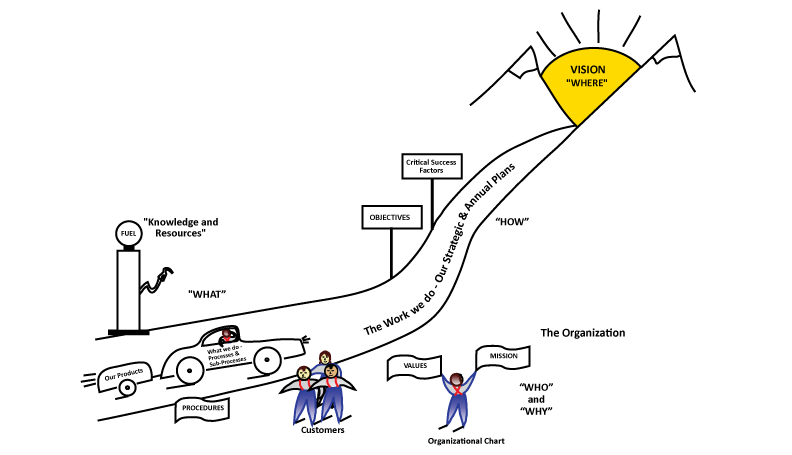
Strategic Leadership - Make Strategic Planning an On-Going Process, Not an Event | Gary Rush Facilitation
I’ve been developing Strategic Plans since the late eighties and teaching others “how to” develop strategic plans since the early nineties. One thing I’ve noticed is that strategic plans, once developed, tend to become “shelf-ware” rather than effective plans. Because Strategic Planning is important to organizations and Strategic Leaders need to set direction, my advice to you is Keep it Simple (KIS).
I read a book by Richard Beeman called, “Plain, Honest Men – The Making of The American Constitution”. One thing that stood out to me is that the US Constitution is only 4 pages long. The fact that we have managed to govern the United States following only a 4-page document for over 200 years, tells me that we should be able to develop a 4-page strategic plan as well, to guide an organization. I was hired by the National Guard in one state to help them develop their strategic plan. Two years earlier, they held an off-site with their senior staff and developed a complicated 84-page strategic plan with lots of metrics. The plan sat on the shelf from the time it was developed until they hired me to develop a new one – no one wanted to look at it and no one understood it. The client and I agreed that the new strategic plan should be only 4 pages long, like our US Constitution. The strategic plan we developed is four (4) pages long and it is now alive and being implemented. This illustrates two key problems when developing strategic plans:
- Off-site retreats are a waste of time.
- Complicated plans never get used.
Off-site retreats are a waste of time.
The problems with off-site retreats are that they are a waste of time and they assume a static plan. When was the last time that the world sat still waiting for the next planning cycle? A strategic plan needs to be alive. General Eisenhower, when asked about plans after World War II, said, “In preparing for battle I have always found that plans are useless, but planning is indispensable.” It is the process of planning, the discussions, the engagement, and the thinking that makes planning effective. In organizations, today, a Strategic Leader, besides setting direction, needs to understand that the world changes daily and a strategic organization needs to quickly adapt. You cannot wait for the next planning cycle. When I facilitate strategic planning, I encourage organizations to develop their plan over a period of time. The advantages are:
- The plan becomes an ongoing process rather than an event. The organization reviews the plan continuously to see if the fast-changing world, the business climate, or the organization has an impact.
- Changes are incorporated more easily because they are being developed over time. There isn’t the pride of authorship that comes from one intense effort.
- The evolving plan is socialized with others. This helps gather input and gain support. Additionally, it helps overcome the biggest employee complaint – not being informed.
- It helps provide time for the planners to think it through. Strategic Planning requires careful thought.
I recommend that strategic planning begin with a one-day session to build the core of the plan – you can review or define the Mission, Vision, a key Value, a key Objective, the current environment, and a key Strategy. The participants take the evolving plan and socialize it; validate assumptions, gather ideas from others, see if the wording and direction make sense, etc. This ensures an accepted, well-thought out plan. That leaves plenty to do in subsequent sessions. Subsequent sessions can last half a day and are scheduled two to four weeks apart. It takes four to five sessions to complete the plan. With the National Guard, we developed the plan in three-day on-site facilitated workshops over 4 months.
Complicated plans never get used.
A strategic plan essentially tells an organization who it is, where it is going, and how it’s going to get there. Don’t get caught up in complicated planning techniques – they are detrimental to organizations. I prefer a one-sentence Mission (who we are), a one-sentence Vision (where we are going), Values (what we believe in), Objectives (targets that we want to accomplish), Current State (I use a numerical matrix to assess internal capabilities against external influences), Strategies (how we’ll accomplish our Objectives), and Critical Success Factors (what is essential). These define all that is needed from a plan and they are easy to understand and remember. Strategic Leaders must keep the plan alive – it guides the organization. If the organization can’t understand or remember it, it becomes “shelf-ware”.
So…
Develop plans over time. Encourage those involved in the planning to bring the evolving plan back to the office and socialize it, involving as many people as possible. Make Strategic Planning an on-going process, not an event.
Plans need to be understood and remembered – it enables the organization to know who they are, where they are headed, what they believe in, what they want to accomplish, and how they will accomplish their objectives. Keep it simple (KIS). ![]()

